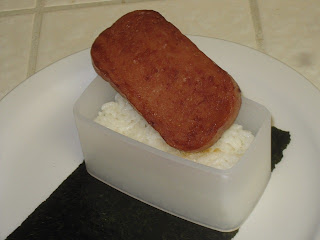This week, we’re going to talk SPAM. Not the spam that promises miracle diets, free iPads, and “natural male enhancement,” SPAM, the Hormel-brand luncheon meat product (yes, Hormel insists that you spell it in all capitals).
You may have heard that people from Hawaii have an unusual predilection for SPAM and dismissed it as a silly stereotype, but if there’s one generalization about locals that hits the mark, this is it: we love our SPAM.
“Eww” would be a succinct summary of the reactions I get from mainlanders, who, from what I gather, associate SPAM with poverty, wartime rationing, and school lunch “mystery meat.” Locals, on the other hand, typically view SPAM as a comfort food that harkens back to a simpler time, perhaps fondly recalling family dinners and field trip home lunches enjoyed with SPAM.
 | |
| Stir-fried SPAM and green beans. Simple and delicious! |
By the numbers, Hawaii consumes around 7 million cans of SPAM (that’s nearly 6 cans per resident) every year, more than any other state in the U.S.! Just ask McDonald’s or Burger King, both of which offer SPAM based dishes on their permanent menus!
So what’s actually in SPAM? Is SPAM really an acronym for Spare Parts of American Meat? Our friends over at The Straight Dope shed some light on some urban myths and common misconceptions (spoilers: SPAM is a mixture of ham and pork, and SPAM is short for “spiced ham”), but the real answer is: who cares? Forget about the silly rumors, dive into the world of SPAM and let your tongue be the judge!
And what better way to learn the joys of SPAM than with the quintessential SPAM dish of choice in Hawaii: the SPAM Musubi!
For those of you who have never had the pleasure of enjoying one, a SPAM musubi consists of a hearty slab of SPAM and a generous hunk of rice wrapped in nori (Japanese-style roasted seaweed). You may be forgiven for thinking that it vaguely resembles sushi because it borrows heavily from Japanese onigiri-style rice balls, but I can assure you that SPAM musubi is as local as you can get. Here's a quick and easy guide to making one for yourself:
What you'll need:
-Musubi mold (can be found at Japanese market like Marukai, Nijiya Market, or Mitsuwa)
-1 can of SPAM (low sodium or lite are both fine choices if you're watching your diet)
-3 cups of cooked white rice
-1 package nori (readily available the Asian foods aisle of most supermarkets)
-Teriyaki marinade (optional)
1. Slice SPAM into slabs of desired thickness (usually 10-12 slices per can) and lightly pan fry (optional, dip each slice into teriyaki marinade beforehand for extra flavor).
2. Fill musubi mold with rice and lay cooked SPAM flat on top.
3. Remove mold and carefully wrap nori around musubi.
Makes 10-12 musubis. Eat them fresh or make like the locals and saran-wrap them for a tasty snack on the go!
And what better way to learn the joys of SPAM than with the quintessential SPAM dish of choice in Hawaii: the SPAM Musubi!
For those of you who have never had the pleasure of enjoying one, a SPAM musubi consists of a hearty slab of SPAM and a generous hunk of rice wrapped in nori (Japanese-style roasted seaweed). You may be forgiven for thinking that it vaguely resembles sushi because it borrows heavily from Japanese onigiri-style rice balls, but I can assure you that SPAM musubi is as local as you can get. Here's a quick and easy guide to making one for yourself:
What you'll need:
-Musubi mold (can be found at Japanese market like Marukai, Nijiya Market, or Mitsuwa)
-1 can of SPAM (low sodium or lite are both fine choices if you're watching your diet)
-3 cups of cooked white rice
-1 package nori (readily available the Asian foods aisle of most supermarkets)
-Teriyaki marinade (optional)
1. Slice SPAM into slabs of desired thickness (usually 10-12 slices per can) and lightly pan fry (optional, dip each slice into teriyaki marinade beforehand for extra flavor).
2. Fill musubi mold with rice and lay cooked SPAM flat on top.
3. Remove mold and carefully wrap nori around musubi.
Makes 10-12 musubis. Eat them fresh or make like the locals and saran-wrap them for a tasty snack on the go!
So leave your preconceptions at the door, try a musubi or two, and you might just see why locals are crazy about SPAM!











